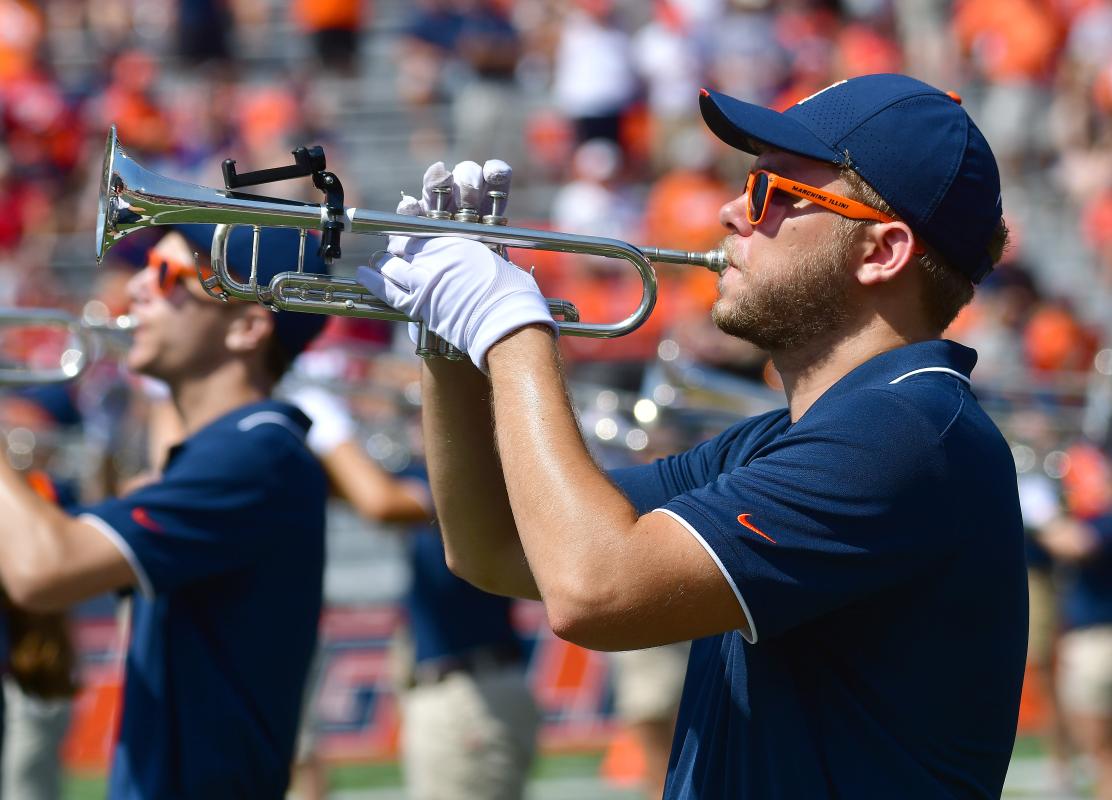
In the three years Colton Williams has been playing bass drum in the Emory & Henry College marching band, he has seen reams of sheet music and performance notes tossed at the end of each season.
But now his band is joining several others across the country that have replaced paper with smartphone apps to save money and be more sustainable.
“It’s really nice having everything in your pocket at all times,” said Williams, a junior who serves as the drum-line captain. “It seems like every year we are getting more technologically savvy, and I honestly love it.”
The biggest plus of ditching paper is feeling like the band is doing its part for the community and the environment, he said.
Emory & Henry band director Matthew Frederick said he decided to make the switch to paperless this summer after hearing from colleagues about the benefits other bands have reaped. Using an app called Ultimate Drill Book has enabled marching band members to more quickly and efficiently learn their parts for the on-field drills they perform during football games.
Created by two brothers who worked with the University of Texas Longhorn Band, the app details different parts of the complicated performances—showing where each band member should stand on the field, the required spacing between members and the different steps involved. Students also can animate the movements they need to make, which is especially beneficial for visual learners.
Since it launched in 2017, the Ultimate Drill Book has seen a steady increase in use by college marching bands, owner Luke Gall said.
So far, the Emory & Henry band has only moved the drill instructions to students’ phones, but Frederick said he is planning to make all the music paperless by early next month. The investment is already paying off, he said.
“From a pedagogical standpoint, it’s fantastic,” he said. “We were able to cover way more than what we initially thought we would be able to because the students were coming up with really awesome, intuitive ways to make it even better, so that was really fun for us.”
Through the app, instructors can update the drill directions with the push of a button—changes that are then reflected on students’ phone screens. Before, Frederick said, a staff member or student would have had to print out the changes, copy them and then distribute the new pages.
“It gives them a lot of intricate details that help them to really learn quickly,” Frederick said. “It really has elevated our teaching ability.”
Olivia Cochrane, a junior music education major and section leader for the band’s trumpets, said using the app has given her ideas about how to use technology in the classroom after she graduates. It’s also helped in her current role teaching her section the drill steps.
In the app, she can see her section and how each member should move. Before, drill instructions were on sheets of paper the size of a hand, and Cochrane said she couldn’t easily see how her section fit in with the overall band or what the performance was supposed to look like.
“It was a lot more guesswork,” she said.
In order to make the switch, Frederick said the band purchased several charging stations and licenses for the app, which costs about $20 per student. Band members can use an iPad or opt for paper if they don’t have a smartphone.
Other marching bands that have gone paperless purchased clamps so students can mount phones on their instruments, similar to a traditional flip book.
Frederick thinks apps like Ultimate Drill Book are the future of college marching bands, though he’s also seen interest from high school ensembles.
“We are certainly not the first nor will we be the last,” he said, adding that it’s a recruiting advantage. “We’re using technology in the best way possible for our students.”
Improved Performance
The Marching Illini at the University of Illinois were among the earliest adopters of a paperless approach. Band director Barry Houser is a big advocate of going digital, and he has shared information about the technology at conferences.
“We’re seeing more collegiate ensembles going this way than ever before, which is great to see,” Houser said. “But there are so many out there that are printing paper drill and they’re printing music.”
He said going paperless has changed how they teach and students learn, improving the band’s overall performance.
“We’re able to achieve a higher level of success,” he said.
Before making the switch, the band was spending $35,000 a year on paper, toner, equipment and staff time to print the music and make paper folders for the band’s nearly 400 students, he said.
The time saved benefits students by enabling more efficient rehearsals, while the money saved has allowed band members to download the technology at no cost.
Houser and Frederick said using available technology for marching band is another way to meet students where they live. As an added bonus, music doesn’t get wet or left at home.
“So many of our students are constantly on their phone or tablet or laptop,” Houser said. “We’re taking something that they’re used to being on and that they’re accustomed to, and we’ve adapted our learning structure and our teaching structure to fit in this mode of understanding that they’re already well connected to rather than fighting them.”
Williams said using his phone at band practice was a big change, but a positive one. He carries a battery pack with him to make sure his phone doesn’t lose power.
“I like how easy it is to access everything, and if they make a change to drill, they can just tell us to download or update the songs, and that way they don’t have to like print out 15 million more copies of music for us to relearn,” he said.
from Inside Higher Ed | News https://ift.tt/pZHIVjt


No comments:
Post a Comment